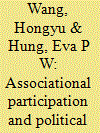|
|
|
Sort Order |
|
|
|
Items / Page
|
|
|
|
|
|
|
| Srl | Item |
| 1 |
ID:
114084


|
|
|
|
|
| Publication |
2012.
|
| Summary/Abstract |
Spatial distribution is an important dimension of research into the development of high technology (hi-tech) industries due to the knowledgeintensive features of these industries. This paper separates the agglomeration effects and the spillover effects, and analyzes the evolution of the spatial distribution of China's hi-tech sub-industries from themid-1990s by combining the geographic concentration index (locational Gini coefficient, concentration ratio) and spatial econometrics (Moran's I). The results reveal that, firstly, most hi-tech subindustries tend to be concentrated in the eastern coastal regions of China, while there are significant spillover effects from the eastern coastal regions to the central regions. The development model based on national hi-tech industrial zones is the primary reason for industrial agglomeration, and it is the result of both government direction andmarket rules. Secondly, on the macro-level, there has been a certain amount of geographical concentration and interregional division of labor among China's hi-tech industries, but there is low intraregional specialization. Furthermore, in contrast to the findings of most of previous studies, the distribution ofChina's hi-tech industries and that of its innovation capacity share similar evolutionary trends, although they do not completely overlap.
|
|
|
|
|
|
|
|
|
|
|
|
|
|
|
|
| 2 |
ID:
042339


|
|
|
|
|
| Publication |
New York, Holt, Rinehart and Winston, 1965.
|
| Description |
xix, 730p.Hardbound
|
|
|
|
|
|
|
|
|
|
|
|
Copies: C:1/I:0,R:0,Q:0
Circulation
| Accession# | Call# | Current Location | Status | Policy | Location |
| 002295 | 519.5354/HOR 002295 | Main | On Shelf | General | |
|
|
|
|
| 3 |
ID:
092853


|
|
|
|
|
| Publication |
2009.
|
| Summary/Abstract |
Energy intensity reflects energy usage efficiency of an economy, in the process of production and consuming of economic output. Why does energy intensity fluctuate in China? In this paper, we explores the distortion of different energy prices, the change of energy structure, technological and final demand structure and their impact on energy intensity in China, based on the path analysis method and input-output structure decomposition model, respectively. And three results have been showed in this paper: first, proved that optimize the relative prices of different types of energy is the most important pricing mechanism when cut down the energy intensity; second, showed that the proportion of oil consumption is the limiting factor that has led to energy intensity change; third, built an input-output structure decomposition analysis model and analyzed technological changes, final demand structure changes, and their direct and indirect impact on energy intensity based on energy input-occupancy-output tables of 30 industry sectors of China in 1992, 1997, 2002 and 2004, which suggest that the fluctuation of energy intensity is mainly due to technology advances and the corresponding change in industrial structure.
|
|
|
|
|
|
|
|
|
|
|
|
|
|
|
|
|
|
|
|
|